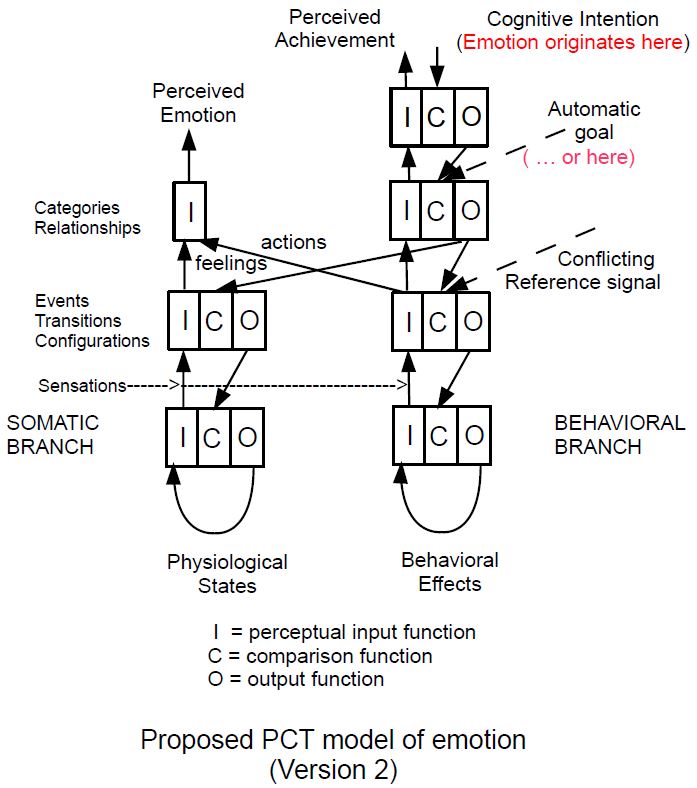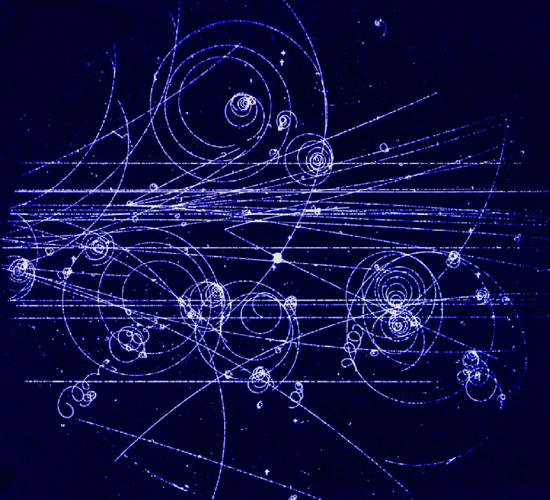Summary: Real Reality is what IS, Perceived Reality is what we perceive to be. They differ, but we can control only what we perceive. If that departs too far from Real Reality in the way it changes as we act on Real Reality, our control will not be very good. The ability to control well attests to there being something “out there” that corresponds to what we perceive in how it reacts to our actions. All we can know is that the “bundle of properties” we perceive an entity to have correspond more or less well to a “budle of properties” in Real Reality.
@@@@@@long message follows@@@@@
Every Living Control System LCS or (organism) lives in an environment. This environment is what offered Hamlet “the slings and arrows of outrageous fortune”. It is where a bacterium finds its food, and it is what allows a tree to take in CO2 and exhale oxygen (or so we perceive it if we believe what we are told). We cannot escape our environment. It is “Real Reality” (RR).
Every organism lives in another reality, a perceived reality (PR). The perceived environment of a bacterium or a tree is presumably much simpler than that of a human, and the perceived reality of a human is presumably a lot simpler than RR. The scientific tools we perceive to exist, even if we don’t ourselves use them, tell us for example that RR contains galaxies whose light was emitted billions of years ago, and that it contains invisible atoms and molecules, some of which emit radiation that could kill us, none of which we can perceive. They exist in our PR because other people who we trust tell us they exist in RR.
But do we have evidence that those people in our PR actually exist in RR? Good stage performers are able to allow is to have in PR persons who are not the actors who portray them. In our PR, on stage there is an actor, but also in our PR, somewhere not in the stage another person exists in a different version of RR. In fact, is there any evidence that anything, anything at all, in our PR corresponds to something in RR?
Yes, there is, and that evidence is provided by the possibility of controlling our perceptions. In the absence of control, it is just abstract philosophy. When we can effectively control a perception, the means of doing so are entirely in RR. But just what is in RR that allows us to control our perceptions? We cannot know more than that whatever it is, when we perceive ourselves to be doing X, something consistently affects our PR. Using this, we can learn how to make a perception consistently change in a particular way by changing X into X1, X2, … until our actions cause the effects in PR that we want.
We can learn in this way constellations of effects that we can manipulate in RR, even if we cannot know whether those effects occur because in PR there are Real Things that match things we perceive in PR, some omniscience and omnipotent being wills the effects to be thus and so or because a vast army of trained bureaucratic gnomes follows orders passed to them through a RR version of the internet.
The mystery then is why we perceive objects in PR, if we have no evidence for their existence in RR.
Norbert Wiener addressed a related issue in the preface to “Cybernetics: The human use of human beings” (at least in the second edition, 1965). The problem he addressed explicitly was one of electrical engineering, but it is easily applied to the RR-PR conundrum. Wiener postulated a “Black Box” (BB) to which an observer/experimenter had no access except through two sets of terminals, one (input) through which E could insert signals and one (output) that produced signals E could measure.
By judicious choice of signals to insert and to observe E could determine relationships among input patterns and output patterns. E could never discover how these relationships were produced inside the BB, but in a “White Box” (WB) E could perhaps design a network of processors that would produce the same set of relationships between its input and output patterns.
The analogy between the BB and RR should be obvious, as should the analogy between E’s problem and two PCT problems often considered independently: Reorganization and the “Test for the Controlled Variable” (TCV). In the TCV, E wants to find one small thing (the controlled perception) in one infinitesimal part of RR (S’s internal processing). Of course, before getting to this point, E has undergone a lifetime of reorganization on top of billions of years of evolutionary “reorganization”, and has built a WB network —a “theory” — of what is in S’s brain, namely a control hierarchy.
How did E reorganize to the point that it was possible to perceive a WB model that performs much as does S in tests? Wiener’s approach was the same as we usually take for early infant development. He first looked for simple, perhaps in inputs to only one terminal, patterns that resulted in consistent effects at one or more output terminals. A baby may wave its arms and legs around apparently at random, but the baby has sensors in the limb that allow it to connect “this” feeling in the limb (output from RR) to “that” movement of the limb (input to RR).
Wiener could readily describe in his WB simple processors (first-level mini-white boxes) that could produce relationship effects at its output (inputs to the experimenter) that matched the simple relationships the BB was observed to produce. The baby likewise could learn to produce some movements at will by linking the feeling with the observation (in the limb, of course, not by analytic thought).
The next stage of Wiener’s procedure was to examine relationships among relationships. When two or more input relationships altered in consistent ways with respect to observed output relationships, Wiener could produce much the same effects by designing a mini-WB that took inputs from his first-level mini-WBs and produced as outputs signals that matched those observed from RR. In reorganization, we would call this the development of a second level of control that used already reorganized first-level structures to produce actual perceptions and output actions, the latter being observable from outside the organism’s body.
Wiener described the procedure as a mathematical procedure to finding ever closer approximations to more and more complex effects produced in his BB and reproducing those approximations as mini-WB processors whose complexity was in large part in the connectivity of the network of mini-WBs, very much as we see the hierarchy of perceptual control structures reorganizing to ever higher-levels of the hierarchy. But NONE of Wiener’s mini-WBs, at any level, were supposed to do what they did because some mini-BB in the Black Box existed to do the same job. In fact, the bureaucracy of industrious gnomes could easily produce the same effects as the network of mini-WBs.
Earlier, I asked what was at that point a rhetorical question "is there any evidence that anything … in our PR corresponds to something in RR?", to which we can now offer a serious semi-answer: “Yes, there may be”. Whether that “may be” can be turned into an “is” depends on how one defines
“anything” and “something”. What we have in every mini-WB except those at the first level, and in every non-first-level perception, a complex of effects produced by the BB or RR respectively. As we perceive them, or as the mini-WB operates on them, those effects are a bundle of “properties” — what the higher-level mini-WB or perceptual “entity” does when influenced in an appropriate way. It is how the “entity” responds to input.
In the larger WB, the Analyst knows exactly what is going on, because the Analyst designed it to do what it does (whether a human analyst has the mental capacity to deal with a large network of mini-WBs is another matter). Some concatenation of signal paths is highly likely to exist in RR, whether it is in the form of an entity or a pile of bureaucratic orders that arrive on the desk of one gnome. A non-first-level mini-WB that produces effects that match something the B does that is not in the individual next-lower-level mini-WBs is very likely to have some corresponding processor in RR.
If Wiener is to be taken as any kind of a guide, reorganization of a perceptual control hierarchy is likely to create perceptions of entities that have some correspondence to something in Real Reality.
Likely but not necessarily. It may not have escaped notice that I have been describing not only reorganization of an individual hierarchy, but also reorganization of Science, which sometimes delves into quite low-level regions of the functional hierarchy.
The mini-WBs of Science may not do the same things as the processing in RR any more than are the mini-WBs of our individual reorganizations, even at levels on which much has been successfully built. For example, Gravity wasn’t a consideration until Newton. Objects had weight as one of their properties, but that had nothing to do with any other object. Newton introduced the idea of gravity as a force field that worked between objects rather than within one (creating a new lower, but not first, level mini-WB entity in the Science WB network). Newton’s gravitational force field modeled RR very well. Then Einstein came along and said that gravity was not a force field but a side-effect of warped space-time — causing a whole lot of disruption of lower-level Scientific entities.
To return to the implications of all this for the Science of PCT, what we could, in principle know with any desired degree of approximation is how effects in RR can be bundled into “properties” of “entities” that we perceive as objects, or as concepts such as the shape of a circle or the literary skill of an author. Those “properties” are very likely to be bundled similarly to permit effects in RR. Nevertheless, what we perceive in RR only behaves like something in RR, without necessarily corresponding to anything that exists in RR other than the effects bundle.
When we control, it is only by influencing some perceived thing in the environment that changes the way something changes in RR that we can do it. The “mini-WB” network we have built is crucial, and that network, we build by reorganization.
I hope that at least some of this makes sense1

